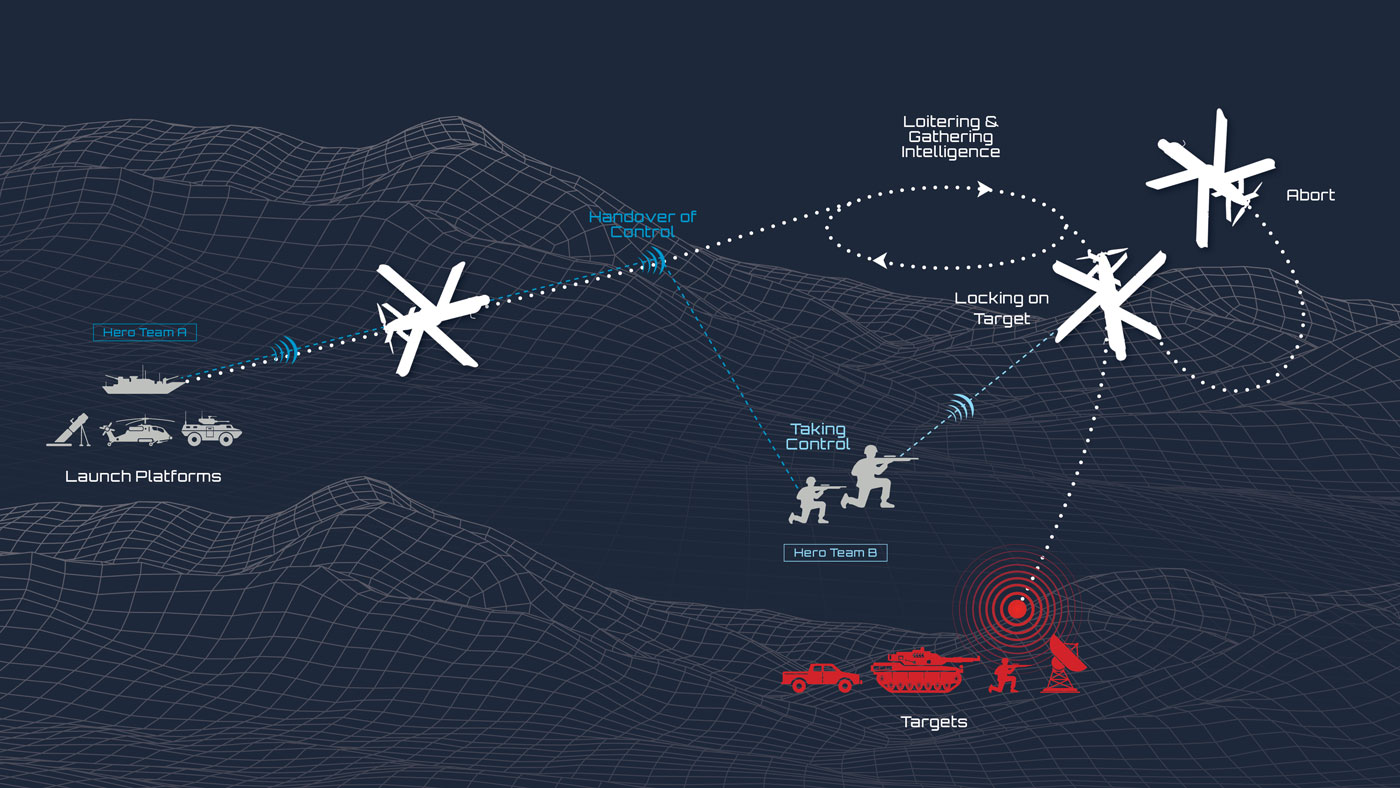Loitering Munitions vs CIWS
Why now: FPV proliferation and the urgent demand for reliable close‑in intercepts have turned loitering munitions vs CIWS into the defining survivability contest of modern warfare.
The contest: guidance, geometry, and seconds that decide outcomes
Loitering munitions mix scouting with a terminal strike. They fly low and small. Some dive fast with narrow radar or IR signatures. Often, terrain and clutter hide them. FPV quadcopters add agile, human‑in‑the‑loop control at platoon to brigade scale. However, close‑in weapon systems (CIWS) form the inner ring of layered defence. They link autonomous sensors to high‑rate guns with airburst rounds or to rapid‑reaction missiles. Therefore, the issue is not who “wins” in theory. It is which sensor‑effector‑tactics blend breaks the kill chain in the final 10–30 seconds.
A modern loitering munitions vs CIWS fight turns on three things. First, detection and track continuity on very small targets. Second, time‑to‑effect—how fast fragments or a proximity‑fused missile arrive. Third, magazine and economy—how long defence can sustain fire under saturation.
What FPV and loitering munitions changed
Recent combat in Ukraine and allied exercises reveal two shifts. First, volume: units can launch hundreds of attritable drones within hours to probe, jam, and strike. Second, adaptation speed: teams modify airframes, seekers, and links in weeks, not years. Consequently, defenders depend on procedural discipline—fast cueing, clear rules in cluttered air pictures, and pre‑authorised fires. They also need technical upgrades such as airburst ammunition and missile‑based CIWS.
At sea, Red Sea operations against mass one‑way UAVs showed the value of pushing intercepts outward. This preserves inner magazines for leakers that slip through medium‑range SAMs. On land, bases and brigades now favour integrated C‑UAS: radar/EO cueing, 35 mm airburst guns, soft‑kill jamming, and, when conditions allow, high‑energy lasers. As a result, commanders can hold key nodes while keeping costs under control.
Guns, missiles, and soft‑kill: what each layer does best
Gun‑based CIWS (20–35 mm, airburst). Systems such as Phalanx and European 35 mm families use autonomous sensors and programmable rounds. These create a fragment cloud in front of the target. As the last mechanical gate, guns offer deep magazines and a low cost‑per‑shot. Moreover, 35 mm airburst (AHEAD/ATOM class) lifts hit probability against low, slow, small threats within several kilometres. This matters when the window to fire is only seconds.
Missile‑based CIWS (RAM/SeaRAM). Small, agile interceptors extend keep‑out range beyond guns. They are valuable against manoeuvring or sea‑skimming threats. In addition, they reduce load on inner guns and help handle multi‑axis raids by engaging earlier.
Soft‑kill and directed energy. Electronic attack can cut control links or blind seekers, which buys seconds. High‑energy lasers promise very low cost‑per‑shot and precise effects. However, weather and availability still limit use. In practice, lasers complement kinetic layers rather than replace them.
Comparative engagement logic
- In a loitering munitions vs CIWS duel at sea, SeaRAM/ RAM engage first to thin the raid and push detonation debris away from the hull; Phalanx or 35 mm airburst then cleans up leakers that have defeated outer layers.
- On land, 35 mm airburst guns (with muzzle‑programmed fuzes) plus RF jamming and rapid sensor hand‑over provide the most repeatable solution against FPV swarms and one‑way attack drones around critical nodes (ammunition parks, C2, bridges). Where available, lasers reduce expenditure rates on benign weather days.
Lessons and data points from credible sources
- U.S. Navy fact files confirm Phalanx’s autonomous search‑to‑kill workflow and its explicit counter‑UAS role—an important doctrinal shift from pure anti‑missile defence. SeaRAM integrates RAM interceptors with CIWS sensors to extend self‑defence envelopes on surface combatants.
- Rheinmetall documentation on 35 mm AHEAD airburst shows muzzle‑programmed, tungsten sub‑projectile payloads that form a dense fragment cone—purpose‑built for small UAVs, loitering munitions and sub‑munition threats.
- ASELSAN GÖKDENİZ—a 35 mm dual‑barrel CIWS using ATOM airburst—illustrates how non‑NATO‑standard producers within NATO partner ecosystems (e.g., Türkiye) deliver comparable effects, with ~4 km effective ranges against aerial targets, depending on fire control and conditions.
- NATO reporting and exercises (NCIA/JAPCC) emphasize interoperability and the need for layered, doctrinally rehearsed counter‑UAS/loitering‑munitions responses across services.
- CRS and CSIS analyses highlight the persistent cost asymmetry between cheap attacking drones and expensive interceptors, reinforcing the value of guns, soft‑kill and, prospectively, directed energy for sustainable defence.
Technical deep‑dive: why airburst works
Programmable airburst rounds use muzzle‑measured velocity to set a time‑of‑burst fuze. The timing resolution is in milliseconds. The projectile then releases 100–150+ tungsten sub‑projectiles in a forward cone. Against small UAVs and loitering munitions, a single direct hit is unlikely. Therefore, the fragment cone raises hit probability and damages propellers, control surfaces, sensors, and warheads. In layered defence, airburst offers geometry‑forgiving lethality. It is less sensitive to last‑second maneuvers or minor track errors.
Tactics: defeating saturation without emptying the magazine
- Cue early, fire late. Use shared radar/EO tracks and EW to classify early, but preserve interceptors until targets commit. Missile‑first for fast, high‑value leakers; guns for the mass of small threats.
- Prioritise nodes, not numbers. Protect C2, logistics, and deck crews first. Accept leakage in peripheral sectors when saturation spikes.
- Mix effectors. Pair 35 mm airburst with RF jamming; add lasers where mature. Train “shot doctrine” to avoid over‑engagement.
- Audit the kill chain. After‑action telemetry (e.g., Phalanx/SeaRAM logs) should inform fuze programming tables, EW settings, and crew drills within 24 hours.
Procurement and design implications
Shipbuilders and land integrators should pre‑wire for sensor fusion across radar, EO/IR, and passive RF. They should also reserve physical and thermal margins for directed‑energy growth. Furthermore, magazine depth matters. Ready‑use ammunition in the 250–1,500‑round range (system dependent) and rapid reload access sustain defence during drone raids. For navies, deck plans that accept both a missile CIWS and a 35 mm airburst mount reduce single‑point failure risk.
For armies, base and brigade kits benefit from containerised 35 mm guns with 3–4 km envelopes, mobile jammers, and layered sensors on likely approach corridors. Doctrine should authorise pre‑planned fires for small‑UAS pictures. Otherwise, decision paralysis is likely when dozens of tracks pop up at once.
Bottom line: there is no silver bullet—only layers that buy seconds
In a straight match‑up of loitering munitions vs CIWS, success goes to the defender who shortens the attacker’s options and conserves ammunition. Guns with airburst remain essential in the inner ring. Missile‑based CIWS pushes threats back and handles fast leakers. Meanwhile, soft‑kill and lasers stabilise costs. Ultimately, there is no silver bullet—only disciplined layers, trained often and measured with data.
References
- U.S. Navy Fact File — MK 15 Phalanx CIWS: navy.mil
- U.S. Navy Fact File — RIM‑116 RAM / SeaRAM: navy.mil
- Rheinmetall — Oerlikon AHEAD® Air‑Burst Ammunition (brochure): rheinmetall.com (PDF)
- Rheinmetall — Oerlikon Revolver Gun Mk3 (35 mm) datasheet: rheinmetall.com (PDF)
- ASELSAN — GÖKDENİZ 35 mm CIWS (brochure): aselsan.com (PDF)
- ASELSAN — ATOM 35 mm Airburst Munition (specs): aselsan.com
- CSIS — Drone Saturation: Russia’s Shahed Campaign: csis.org
- CRS — Department of Defense Counter‑Unmanned Aircraft Systems (R48477): everycrsreport.com (PDF)
- NATO NCIA — Counter‑drone interoperability exercise (2024): ncia.nato.int
- NATO — Secretary General’s Annual Report 2024: nato.int (PDF)
- RUSI — Tactical Developments in the Third Year of the Russo‑Ukrainian War: rusi.org (PDF)
- FOI (Swedish Defence Research Agency) — FPV drones memo (2025): foi.se (PDF)
- USCENTCOM — Red Sea updates on UAS interceptions: centcom.mil
- CRS — Navy Shipboard Lasers (R44175) — background & issues: congress.gov
Further Reading
When helicopters launch drones: the next layer in distributed lethality
Defence & Aerospace Strategic Trends — Editorial Hub
CSIS: Cost and Value in Air & Missile Defense Intercepts
JAPCC Annual Report 2024 — C‑UAS observations








